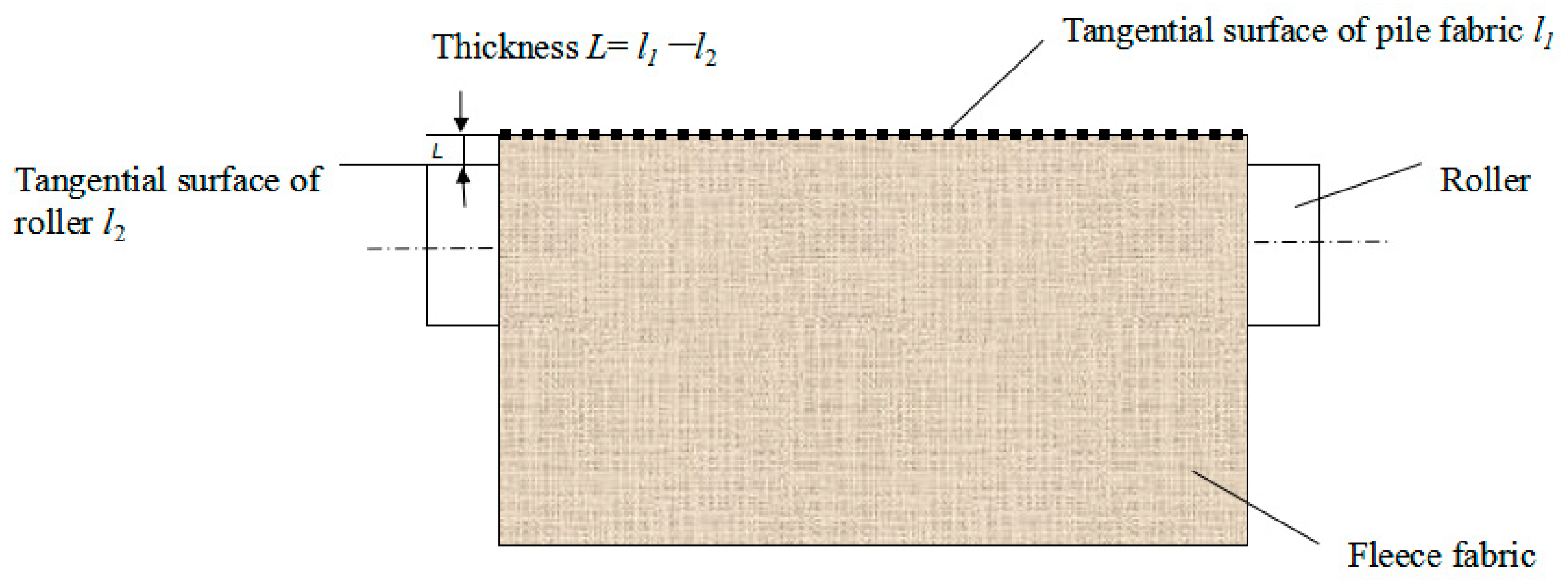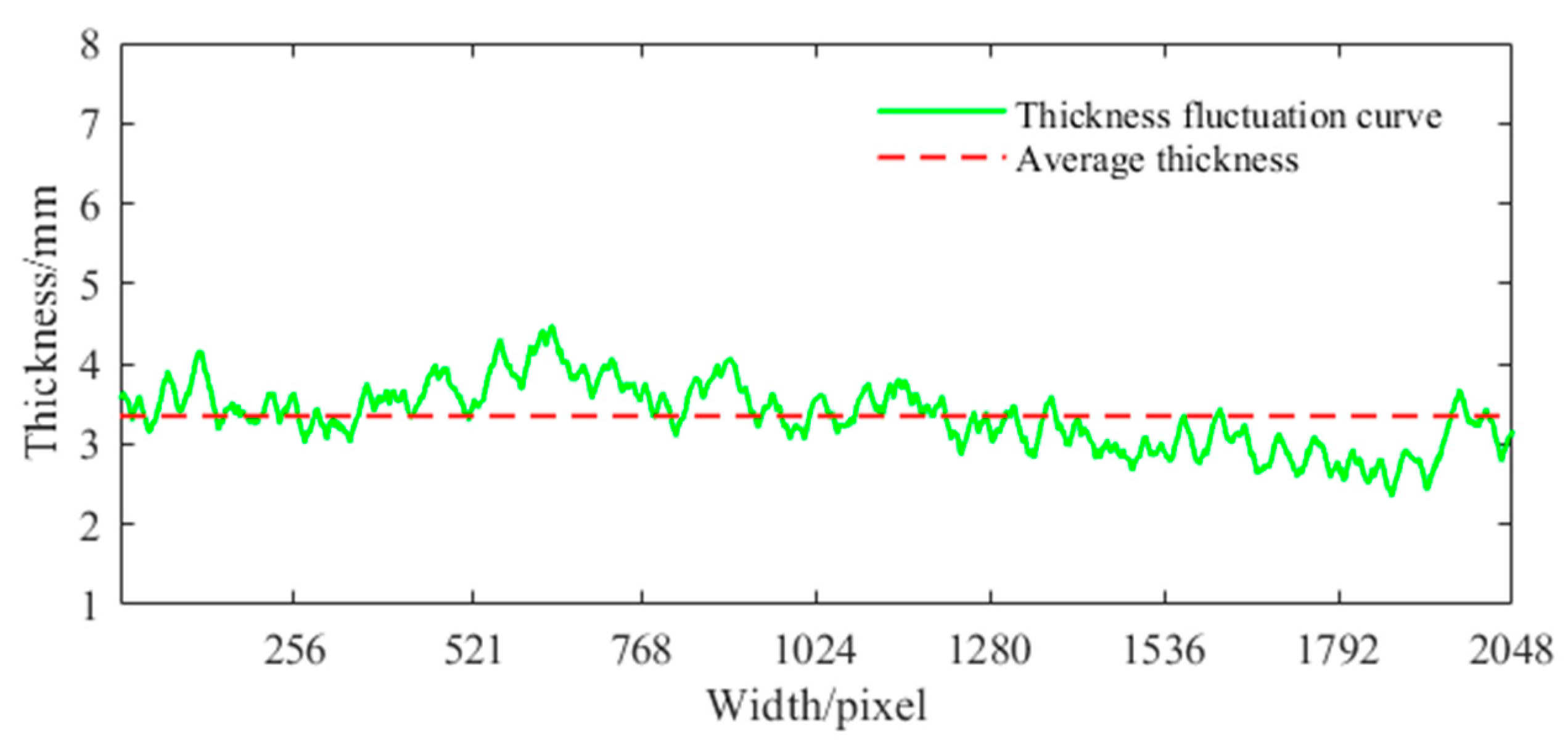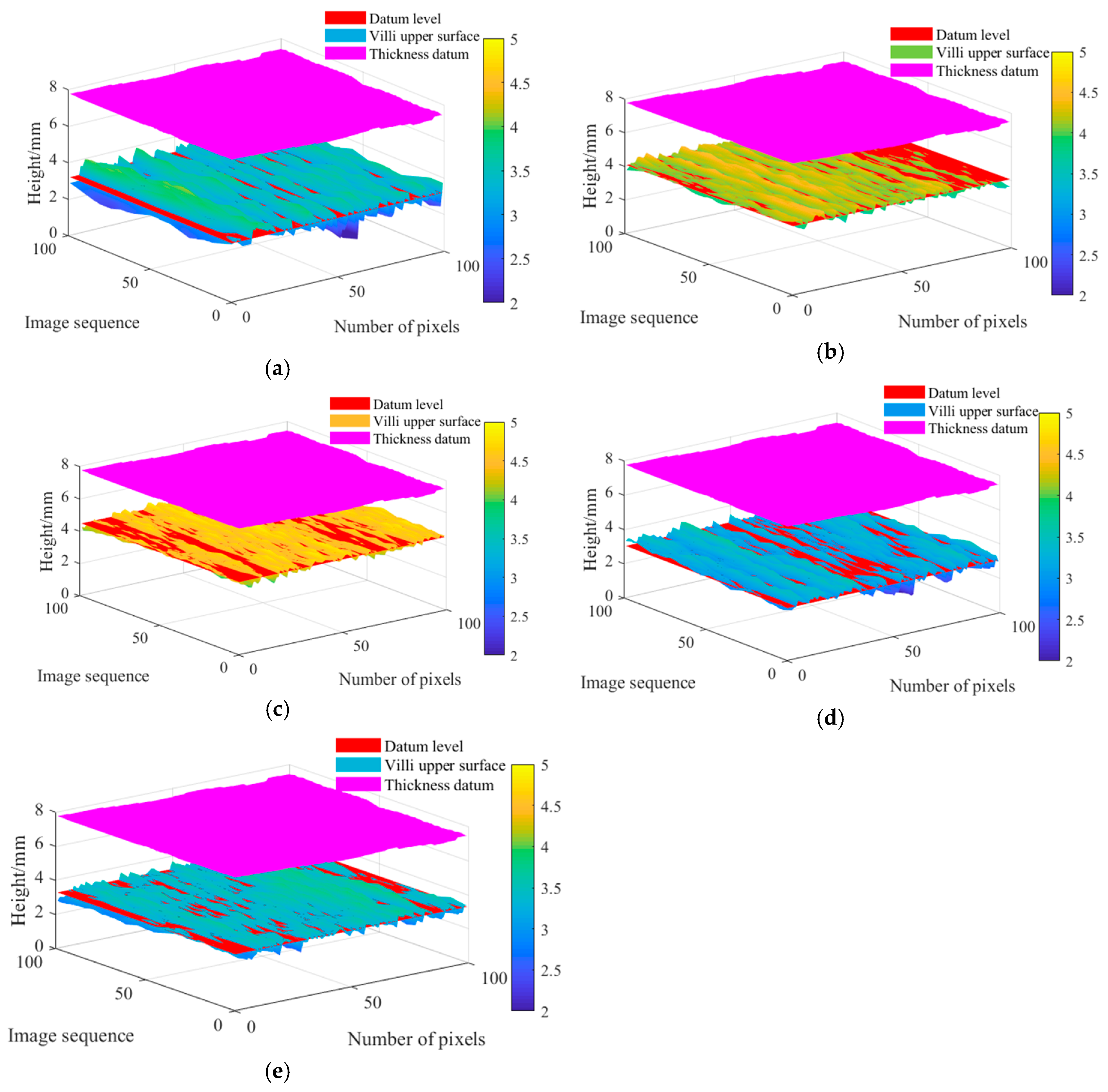Three-Dimensional Reconstruction of Fleece Fabric Surface for Thickness Evaluation
Abstract
1. Introduction
2. Materials and Methods
2.1. Bench Tester
2.2. 2D Image Processing
2.3. 3D Image Reconstruction
3. Surface Quality Estimation
3.1. Modelling of Fabric Thickness
3.2. Parametric Model of Undulation Degree of Fabric Surface
4. Experimental Results
4.1. Fabric Thickness Estimation
4.2. Discussion
5. Conclusions
Author Contributions
Funding
Conflicts of Interest
Appendix A
| Fabric Sample | Number of Frames | Single Frame Thickness/mm | |||||||||
|---|---|---|---|---|---|---|---|---|---|---|---|
| a | 1–10 | 5.04 | 5.02 | 5.01 | 4.95 | 4.92 | 4.15 | 4.13 | 4.09 | 4.12 | 4.12 |
| 11–20 | 4.03 | 3.91 | 3.99 | 3.90 | 3.89 | 4.28 | 4.24 | 4.47 | 4.38 | 4.21 | |
| 21–30 | 4.21 | 4.55 | 4.50 | 4.56 | 4.38 | 4.71 | 4.38 | 4.36 | 4.38 | 4.37 | |
| 31–40 | 4.35 | 4.06 | 4.20 | 4.14 | 4.41 | 4.40 | 4.66 | 4.56 | 4.56 | 4.44 | |
| 41–50 | 4.00 | 4.05 | 4.08 | 4.12 | 4.50 | 4.89 | 4.68 | 5.10 | 4.43 | 4.07 | |
| 51–60 | 4.62 | 4.74 | 4.31 | 5.33 | 5.06 | 4.10 | 4.08 | 4.17 | 4.38 | 5.10 | |
| 61–70 | 4.65 | 4.63 | 4.61 | 4.11 | 4.05 | 4.27 | 4.11 | 4.10 | 4.65 | 4.38 | |
| 71–80 | 4.25 | 4.47 | 4.58 | 4.05 | 4.36 | 4.44 | 4.35 | 4.24 | 4.48 | 4.11 | |
| 81–90 | 4.21 | 4.16 | 4.18 | 4.10 | 4.34 | 4.00 | 3.88 | 3.87 | 4.15 | 4.09 | |
| 91–100 | 4.54 | 4.60 | 4.56 | 4.07 | 3.98 | 4.00 | 4.23 | 4.24 | 4.40 | 4.48 | |
| b | 1–10 | 3.73 | 3.71 | 3.69 | 3.65 | 3.61 | 3.67 | 3.67 | 3.65 | 3.62 | 3.56 |
| 11–20 | 3.55 | 3.54 | 3.49 | 3.49 | 3.52 | 3.41 | 3.40 | 3.79 | 3.79 | 3.73 | |
| 21–30 | 3.73 | 3.58 | 3.63 | 3.39 | 3.40 | 3.46 | 3.41 | 3.36 | 3.66 | 3.67 | |
| 31–40 | 3.35 | 3.39 | 3.32 | 3.31 | 3.36 | 3.60 | 3.40 | 3.39 | 3.42 | 3.42 | |
| 41–50 | 3.36 | 3.43 | 3.29 | 3.29 | 3.29 | 3.45 | 3.46 | 3.37 | 3.29 | 3.29 | |
| 51–60 | 3.53 | 3.43 | 3.38 | 3.39 | 3.36 | 3.54 | 3.56 | 3.52 | 3.46 | 3.46 | |
| 61–70 | 3.37 | 3.36 | 3.60 | 3.60 | 3.51 | 3.63 | 3.63 | 3.34 | 3.34 | 3.44 | |
| 71–80 | 3.44 | 3.54 | 3.64 | 3.68 | 3.57 | 3.53 | 3.56 | 3.41 | 3.38 | 3.44 | |
| 81–90 | 3.46 | 3.36 | 3.41 | 3.41 | 3.35 | 3.24 | 3.41 | 3.40 | 3.34 | 3.38 | |
| 91–100 | 3.62 | 3.55 | 3.45 | 3.55 | 3.63 | 3.55 | 3.59 | 3.64 | 3.63 | 3.62 | |
| c | 1–10 | 3.25 | 3.34 | 3.31 | 3.36 | 3.39 | 3.46 | 3.42 | 3.34 | 3.35 | 3.33 |
| 11–20 | 3.30 | 3.32 | 3.25 | 3.17 | 3.32 | 3.32 | 3.30 | 3.43 | 3.55 | 3.43 | |
| 21–30 | 3.20 | 3.240 | 3.23 | 3.21 | 3.22 | 3.16 | 3.18 | 3.13 | 3.20 | 3.23 | |
| 31–40 | 2.95 | 3.00 | 3.02 | 3.17 | 3.02 | 2.88 | 2.91 | 2.93 | 2.93 | 2.89 | |
| 41–50 | 3.02 | 2.98 | 2.97 | 2.89 | 2.99 | 2.74 | 2.77 | 2.88 | 3.01 | 2.90 | |
| 51–60 | 3.04 | 3.00 | 2.96 | 2.79 | 3.01 | 3.11 | 3.14 | 3.14 | 3.13 | 3.06 | |
| 61–70 | 3.23 | 3.190 | 3.14 | 3.06 | 3.17 | 3.25 | 3.21 | 3.20 | 3.21 | 3.19 | |
| 71–80 | 3.21 | 3.22 | 3.17 | 3.10 | 3.29 | 3.11 | 3.13 | 3.09 | 3.26 | 3.07 | |
| 81–90 | 2.80 | 2.94 | 2.82 | 2.96 | 2.82 | 2.73 | 2.77 | 2.71 | 2.70 | 2.72 | |
| 91–100 | 2.77 | 2.80 | 2.80 | 2.85 | 2.88 | 2.85 | 2.81 | 2.92 | 2.84 | 2.86 | |
| d | 1–10 | 4.63 | 4.62 | 4.69 | 4.67 | 4.70 | 4.49 | 4.45 | 4.43 | 4.43 | 4.49 |
| 11–20 | 4.55 | 4.60 | 4.55 | 4.61 | 4.57 | 4.50 | 4.47 | 4.51 | 4.45 | 4.42 | |
| 21–30 | 4.48 | 4.57 | 4.59 | 4.68 | 4.76 | 4.24 | 4.26 | 4.26 | 4.34 | 4.41 | |
| 31–40 | 4.74 | 4.58 | 4.59 | 4.59 | 4.30 | 4.52 | 4.50 | 4.48 | 4.49 | 4.52 | |
| 41–50 | 4.48 | 4.61 | 4.71 | 4.70 | 4.59 | 4.88 | 4.58 | 5.06 | 4.34 | 4.48 | |
| 51–60 | 4.61 | 5.02 | 4.51 | 4.96 | 4.66 | 4.57 | 4.53 | 4.59 | 4.77 | 5.01 | |
| 61–70 | 4.59 | 4.57 | 4.58 | 4.65 | 4.65 | 4.36 | 4.39 | 4.43 | 4.57 | 4.53 | |
| 71–80 | 4.49 | 4.49 | 4.43 | 4.38 | 4.38 | 4.48 | 4.53 | 4.57 | 4.46 | 4.35 | |
| 81–90 | 4.09 | 4.16 | 4.29 | 4.42 | 4.39 | 4.23 | 4.23 | 3.99 | 4.22 | 4.22 | |
| 91–100 | 4.67 | 4.64 | 4.70 | 4.16 | 4.14 | 4.58 | 4.89 | 4.86 | 4.38 | 4.65 | |
| e | 1–10 | 4.64 | 4.68 | 4.62 | 4.67 | 4.67 | 4.54 | 4.45 | 4.55 | 4.55 | 4.45 |
| 11–20 | 4.32 | 4.33 | 4.35 | 4.33 | 4.38 | 4.55 | 4.53 | 4.54 | 4.56 | 4.47 | |
| 21–30 | 4.33 | 4.79 | 4.30 | 4.61 | 4.83 | 4.42 | 4.37 | 4.59 | 4.55 | 4.34 | |
| 31–40 | 4.25 | 4.30 | 4.31 | 4.43 | 4.37 | 4.25 | 4.25 | 4.18 | 4.20 | 4.21 | |
| 41–50 | 4.14 | 4.13 | 4.30 | 4.13 | 4.13 | 4.09 | 4.11 | 4.09 | 4.19 | 4.14 | |
| 51–60 | 4.25 | 4.15 | 4.14 | 3.99 | 4.18 | 4.36 | 4.36 | 4.22 | 4.33 | 4.03 | |
| 61–70 | 4.16 | 4.18 | 4.33 | 4.10 | 4.16 | 3.86 | 4.24 | 4.11 | 4.07 | 4.24 | |
| 71–80 | 4.02 | 3.80 | 4.09 | 3.90 | 4.00 | 4.14 | 4.03 | 4.14 | 4.14 | 4.11 | |
| 81–90 | 4.22 | 4.10 | 3.74 | 4.14 | 4.19 | 4.17 | 4.23 | 3.88 | 4.34 | 4.24 | |
| 91–100 | 4.23 | 4.11 | 4.31 | 4.10 | 4.02 | 4.36 | 4.32 | 4.35 | 4.27 | 4.38 | |
References
- Yang, S.L.; Ma, S.; Ding, C.P. Textile surface fleece rate test system using machine vision. Text. J. 2017, 38, 119–123. [Google Scholar]
- Zhao, B.; Zheng, L.X.; Pan, X.L. New fabric defect detection algorithm based on image saliency area features. J. Comput. Appl. 2012, 32, 90–93. [Google Scholar]
- Tropp, M.; Brumerčík, F.; Šteininger, J.; Weis, P.; Glowacz, A. Heat distribution in the deep drawing device components working by high temperatures. IOP Conf. Ser. Mater. Sci. Eng. 2018, 393, 012075. [Google Scholar] [CrossRef]
- Banumathi, P.; Nasira, G.M. Fabric Inspection System using Artificial Neural Networks. Int. J. Comput. Eng. Sci. 2012, 2, 20–27. [Google Scholar]
- Jasinska, I. Assessment of a fabric surface after the pilling process based on image analysis. Fibres Text. East. Eur. 2009, 17, 55–58. [Google Scholar]
- Jing, J.; Li, P.; Long, G. The improved algorithm for color-texture image segmentation. In Proceedings of the IEEE 3rd International Conference on Communication Software and Networks, Xi’an, China, 27–29 May 2011. [Google Scholar]
- Jin, J.; Kang, X. Fabric Pilling Image Segmentation Based on Mean Shift. In Proceedings of the International Conference on Electronic Commerce, Web Application, and Communication, Guangzhou, China, 16–17 April 2011; Volume 104, pp. 80–84. [Google Scholar]
- SariSarraf, H.; Goddard, J.S. Vision system for on-loom fabric inspection. IEEE Trans. Ind. Appl. 1999, 35, 1252–1259. [Google Scholar]
- Chan, C.H.; Pang, G. Fabric defect detection by Fourier analysis. In Proceedings of the 1999 IEEE Industry Applications Conference, Phoenix, AZ, USA, 6 August 2002. [Google Scholar] [CrossRef][Green Version]
- Kuo, C.F.J.; Su, T.L.; Chang, C.D. Intelligence control of on-line dynamic gray cloth inspecting machine system module design. II. Defects inspecting module design. Fibers Polym. 2008, 9, 768–775. [Google Scholar] [CrossRef]
- Bharathi, S.; Vasuki, A. 2D-to-3D Conversion of Images Using Edge Information. In Proceedings of the IJCA Proceedings on International Conference in Recent trends in Computational Methods, Communication and Controls (ICON3C 2012), Coimbatore, Nadu, India, 1–5 April 2012; pp. 27–32. [Google Scholar]
- Kang, T.J.; Cho, D.H.; Kim, S.M. Objective Evaluation of Fabric Pilling Using Stereovision. Text. Res. J. 2004, 74, 1013–1017. [Google Scholar] [CrossRef]
- Yu, L.J.; Wang, R.W. A novel three-dimensional reconstruction algorithms for nonwoven fabrics based on sequential two dimensional images. In Proceedings of the International Conference on Advanced Materials, Structures and Mechanical Engineering, Incheon, Korea, 29–31 May 2015. [Google Scholar]
- Kim, S.; Chang, K.P. Evaluation of fabric pilling using hybrid imaging methods. Fibers Polym. 2006, 7, 57–61. [Google Scholar] [CrossRef]
- Tilocca, A.; Borzone, P.; Carosio, S. Detecting fabric defects with a neural network using two kinds of optical pattems. Text. Res. J. 2002, 72, 545–550. [Google Scholar] [CrossRef]
- Ouyang, W. Evaluating Fabric Pilling/Wrinkling Appearance Using 3D Images. Master’s Thesis, The University of Texas, Austin, TX, USA, 2013. [Google Scholar]
- Saharkhiz, S.; Abdorazaghi, M. The Performance of Different Clustering Methods in the Objective Assessment of Fabric Pilling. J. Eng. Fibers Fabr. 2012, 7, 35–41. [Google Scholar] [CrossRef]
- Taylor, K.A.; Schmitz, H.; Reedy, M.C.; Goldman, Y.E.; Franzini-Armstrong, C.; Sasaki, H.; Tregear, R.T.; Poole, K.; Lucaveche, C.; Edwards, R.J.; et al. Tomographic 3D reconstruction of quick-frozen, Ca2+-activated contracting insect flight muscle. Cell 1999, 99, 421–431. [Google Scholar] [CrossRef]
- Ems-Mcclung, S.C.; Walczak, C.E. Catastrophic kinesins: Piecing together their mechanism by 3D reconstruction. Cell 2004, 116, 485–486. [Google Scholar]
- Deng, J.; Newton, N.M.; Hall-Craggs, M.A. Novel technique for three-dimensional visualisation and quantification of deformable, moving soft-tissue body parts. Lancet 2000, 356, 127–131. [Google Scholar] [CrossRef]
- Donnelly, C.; Guizar-Sicairos, M.; Scagnoli, V. Three-dimensional magnetization structures revealed with X-ray vector nanotomography. Nature 2017, 547, 328–331. [Google Scholar] [CrossRef]
- He, P.; Shen, Y.; Gu, Y. 3D fracture modelling and limit state analysis of prestressed composite concrete pipes. Front. Struct. Civil. Eng. 2019, 13, 165–175. [Google Scholar] [CrossRef]
- Udayan, J.D.; Kim, H.S.; Kim, J.I. Animage-based approach to the reconstruction of ancient architectures by extracting and arranging 3D spatial components. Front. Inf. Technol. Electron. Eng. 2015, 16, 12–27. [Google Scholar] [CrossRef]
- Buxton, F.; Bernard, F. Development of an Extension of the Otsu Algorithm for Multidimensional Image Segmentation of Thin-Film Blood Slides. In Proceedings of the 2007 International Conference on Computing: Theory and Applications (ICCTA 2007), Kolkata, India, 5–7 March 2007. [Google Scholar]
- Ya, B.D.; Ming, F.L.; Xiao, L.Z. Faults diagnosis of rolling element bearings based on modified morphological method. Mech. Syst. Signal. Process. 2011, 25, 1276–1286. [Google Scholar]
- Ding, L.; Goshtasby, A. On the Canny edge detector. Pattern. Recognit. 2001, 34, 721–725. [Google Scholar] [CrossRef]
- Wang, J.; Song, W.; Zhao, L. Application of Improved Freeman Chain Code in Edge Tracking and Straight Line Extraction. J. Signal. Process. 2014, 30, 422–430. [Google Scholar]
- Liu, W.; Cheng, Y.; Sawant, A. A robust real-time surface reconstruction method on point clouds captured from a 3D surface photogrammetry system. Med. Phys. 2016, 43, 2353–2360. [Google Scholar] [CrossRef]
- Xiao, G.J.; Dong, Q.; Wang, Y.N.; Sui, Y.M.; Ning, J.J.; Liu, Z.Y.; Tian, W.J.; Liu, B.B.; Zou, G.T.; Zou, B. One-Step Solution Synthesis of Bismuth Sulfide (Bi2S3) with Various Hierarchical Architectures and Their Photoresponse Properties. RSC Adv. 2012, 2, 234–240. [Google Scholar] [CrossRef]
- Cipolla, R.; Robenson, D.P.; Boyer, E.G. Photobuilder-3D Models of Architectural scenes from uncalibmted Images. In Proceedings of the IEEE International Conference on Multimedia Computing and Systems, Florence, Italy, 7–11 June 1999; pp. 25–30. [Google Scholar]









| Fabric Sample | Gq (mm) | Estimated Thickness (mm) | Measured Thickness (mm) | Error |
|---|---|---|---|---|
| a | 0.431 | 4.36 | 3.10 | 28.9% |
| b | 0.201 | 3.49 | 2.96 | 15.2% |
| c | 0.190 | 3.08 | 2.76 | 10.4% |
| d | 0.299 | 4.52 | 3.25 | 28.1% |
| e | 0.252 | 4.27 | 3.61 | 15.5% |
© 2020 by the authors. Licensee MDPI, Basel, Switzerland. This article is an open access article distributed under the terms and conditions of the Creative Commons Attribution (CC BY) license (http://creativecommons.org/licenses/by/4.0/).
Share and Cite
Jin, S.; Chen, Y.; Yin, J.; Li, Y.; Gupta, M.K.; Fracz, P.; Li, Z. Three-Dimensional Reconstruction of Fleece Fabric Surface for Thickness Evaluation. Electronics 2020, 9, 1346. https://doi.org/10.3390/electronics9091346
Jin S, Chen Y, Yin J, Li Y, Gupta MK, Fracz P, Li Z. Three-Dimensional Reconstruction of Fleece Fabric Surface for Thickness Evaluation. Electronics. 2020; 9(9):1346. https://doi.org/10.3390/electronics9091346
Chicago/Turabian StyleJin, Shoufeng, Yang Chen, Jiajie Yin, Yi Li, Munish Kumar Gupta, Pawel Fracz, and Zhixiong Li. 2020. "Three-Dimensional Reconstruction of Fleece Fabric Surface for Thickness Evaluation" Electronics 9, no. 9: 1346. https://doi.org/10.3390/electronics9091346
APA StyleJin, S., Chen, Y., Yin, J., Li, Y., Gupta, M. K., Fracz, P., & Li, Z. (2020). Three-Dimensional Reconstruction of Fleece Fabric Surface for Thickness Evaluation. Electronics, 9(9), 1346. https://doi.org/10.3390/electronics9091346






